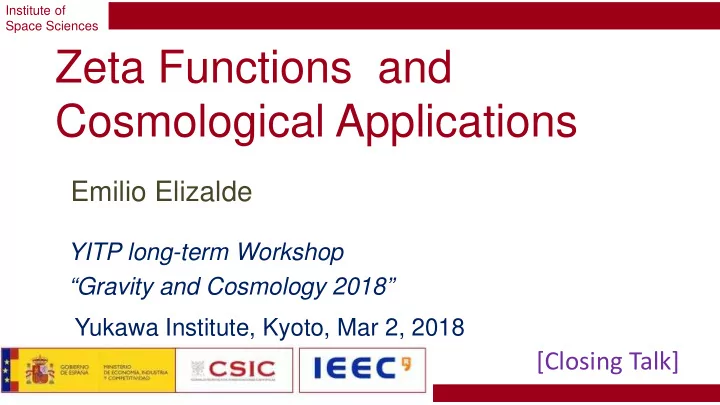

Institute of Space Sciences Zeta Functions and Cosmological Applications Emilio Elizalde YITP long-term Workshop “Gravity and Cosmology 2018” Yukawa Institute, Kyoto, Mar 2, 2018 [Closing Talk] Name or Title or Xtra
Zero point energy vacuum to vacuum transition: � 0 | H | 0 � QFT Spectrum, normal ordering (harm oscill): � � n + 1 λ n a n a † H = n 2 � λ n = 1 � 0 | H | 0 � = � c 2 tr H 2 n gives ∞ physical meaning? Regularization + Renormalization ( cut-off, dim, ζ ) Even then: Has the final value real sense ? QFEXT 2011, CC Pedro Pascual, Benasque, Sep 18-24, 2011 – p. 3/2
Institute of Space Sciences Effects of the Quantum Vacuum ̴ 10 -5 a) Negligible: Sonoluminiscence, Schwinger b) Important: Wetting He3 – alcali ̴ 30% ̴ 10 120 c) Incredibly big: Cosmological constant GC2018, Kyoto, 2 Mar 2018 Name or Title or Xtra
Riemann Zeta Function ������������������ ������������������ s ������������������ ������������������ ������������������ ������������������ ������������������ ������������������ ������������������ ������������������ ������������������ ������������������ a.c. ������������������ ������������������ ������������������ ������������������ ������������������ ������������������ 1 ������������������ ������������������ Σ ζ (s) = −− ������������������ ������������������ ns ������������������ ������������������ ������������������ ������������������ ������������������ ������������������ (s) ζ ������������������ ������������������ ������������������ ������������������ ������������������ ������������������ ������������������ ������������������ ������������������ ������������������ ������������������ ������������������ ������������������ ������������������ ������������������ ������������������ pole ������������������ ������������������ � � � � ������������������ ������������������ −4 −3 −2 −1 0 1 2 3 4 5 ������������������ ������������������ ������������������ ������������������ ������������������ ������������������ ������������������ ������������������ ������������������ ������������������ ������������������ ������������������ ������������������ ������������������ ������������������ ������������������ ������������������ ������������������ ������������������ ������������������ ������������������ ������������������ ������������������ ������������������ ������������������ ������������������
F Yndurain, A Slavnov "As everybody knows ..."
Operator Zeta F’s in M Φ : Origins The Riemann zeta function ζ ( s ) is a function of a complex variable, s . To define it, one � ∞ starts with the infinite series 1 n s n =1 which converges for all complex values of s with real Re s > 1 , and then defines ζ ( s ) as the analytic continuation, to the whole complex s − plane, of the function given, Re s > 1 , by the sum of the preceding series. Leonhard Euler already considered the above series in 1740, but for positive integer values of s , and later Chebyshev extended the definition to Re s > 1 . Godfrey H Hardy and John E Littlewood, “Contributions to the Theory of the Riemann Zeta-Function and the Theory of the Distribution of Primes", Acta Math 41, 119 (1916) Did much of the earlier work, by establishing the convergence and equivalence of series regularized with the heat kernel and zeta function regularization methods G H Hardy, Divergent Series (Clarendon Press, Oxford, 1949) Srinivasa I Ramanujan had found for himself the functional equation of the zeta function Torsten Carleman, “Propriétés asymptotiques des fonctions fondamentales des membranes vibrantes" (French), 8. Skand Mat-Kongr, 34-44 (1935) Zeta function encoding the eigenvalues of the Laplacian of a compact Riemannian manifold for the case of a compact region of the plane QFEXT 2011, CC Pedro Pascual, Benasque, Sep 18-24, 2011 – p. 4/2
Robert T Seeley, “Complex powers of an elliptic operator. 1967 Singular Integrals" (Proc. Sympos. Pure Math., Chicago, Ill., 1966) pp. 288-307, Amer. Math. Soc., Providence, R.I. Extended this to elliptic pseudo-differential operators A on compact Riemannian manifolds. So for such operators one can define the determinant using zeta function regularization D B Ray, Isadore M Singer, “ R -torsion and the Laplacian on Riemannian manifolds", Advances in Math 7, 145 (1971) Used this to define the determinant of a positive self-adjoint operator A (the Laplacian of a Riemannian manifold in their application) with eigenvalues a 1 , a 2 , ...., and in this case the zeta function is formally the trace ζ A ( s ) = Tr ( A ) − s the method defines the possibly divergent infinite product ∞ � ′ (0)] a n = exp[ − ζ A n =1 QFEXT 2011, CC Pedro Pascual, Benasque, Sep 18-24, 2011 – p. 5/2
J. Stuart Dowker, Raymond Critchley “Effective Lagrangian and energy-momentum tensor in de Sitter space", Phys. Rev. D13, 3224 (1976) Abstract The effective Lagrangian and vacuum energy-momentum tensor < T µν > due to a scalar field in a de Sitter space background are calculated using the dimensional-regularization method. For generality the scalar field equation is chosen in the form ( � 2 + ξR + m 2 ) ϕ = 0 . If ξ = 1 / 6 and m = 0 , the renormalized < T µν > equals g µν (960 π 2 a 4 ) − 1 , where a is the radius of de Sitter space. More formally, a general zeta-function method is developed. It yields the renormalized effective Lagrangian as the derivative of the zeta function on the curved space. This method is shown to be virtually identical to a method of dimensional regularization applicable to any Riemann space. QFEXT 2011, CC Pedro Pascual, Benasque, Sep 18-24, 2011 – p. 6/2
Recommend
More recommend